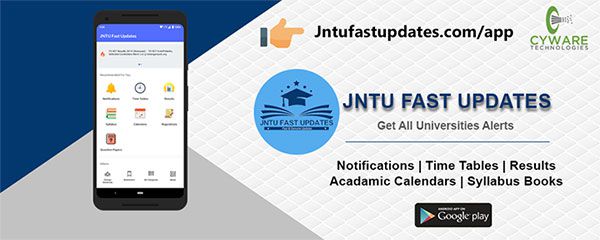JNTUK R16 4-1 MEFA Material/Notes PDF Download
Students those who are studying JNTUK R16 CSE Branch, Can Download Unit wise R16 4-1 Managerial Economics & Financial Analysis (MEFA) Material/Notes PDFs below.

JNTUK R16 4-1 MEFA Material/Notes PDF Download
Course Objectives: This course is designed to:
- The Learning objectives of this paper is to understand the concept and nature of Managerial Economics and its relationship with other disciplines and also to understand the Concept of Demand and Demand forecasting, Production function, Input Output relationship, CostOutput relationship and Cost-Volume-Profit Analysis.
- To understand the nature of markets, Methods of Pricing in the different market structures and to know the different forms of Business organization and the concept of Business Cycles.
- To learn different Accounting Systems, preparation of Financial Statement and uses of different tools for performance evaluation. Finally, it is also to understand the concept of Capital, Capital Budgeting and the techniques used to evaluate Capital Budgeting proposals.
UNIT-1
Introduction to Managerial Economics and demand Analysis: Definition of Managerial Economics –Scope of Managerial Economics and its relationship with other subjects –Concept of Demand, Types of Demand, Determinants of Demand- Demand schedule, Demand curve, Law of Demand and its limitations- Elasticity of Demand, Types of Elasticity of Demand and Measurement- Demand forecasting and Methods of forecasting, Concept of Supply and Law of Supply.
Unit-2
Production and Cost Analyses: Concept of Production function- Cobb-Douglas Production function- Leontief production function – Law of Variable proportions-Isoquants and Isocosts and choice of least cost factor combination-Concepts of Returns to scale and Economies of scale-Different cost concepts: opportunity costs, explicit and implicit costs- Fixed costs, Variable Costs and Total costs –Cost – Volume-Profit analysis-Determination of Breakeven point(simple problems)-Managerial significance and limitations of Breakeven point.
Unit-3
Introduction to Markets, Theories of the Firm & Pricing Policies: Market Structures: Perfect Competition, Monopoly, Monopolistic competition and Oligopoly – Features – Price and Output Determination – Managerial Theories of firm: Marris and Williamson’s models – other Methods of Pricing: Average cost pricing, Limit Pricing, Market Skimming Pricing, Internet Pricing: (Flat Rate Pricing, Usage sensitive pricing) and Priority Pricing.
UNIT-4
Types of Business Organization and Business Cycles: Features and Evaluation of Sole Trader, Partnership, Joint Stock Company – State/Public Enterprises and their forms – Business Cycles : Meaning and Features – Phases of a Business Cycle.
Unit-5
Introduction to Accounting & Financing Analysis: Introduction to Double Entry Systems – Preparation of Financial Statements-Analysis and Interpretation of Financial Statements-Ratio Analysis – Preparation of Funds flow and cash flow statements (Simple Problems)
Unit-6
Capital and Capital Budgeting: Capital Budgeting: Meaning of Capital-CapitalizationMeaning of Capital Budgeting-Time value of money- Methods of appraising Project profitability: Traditional Methods(pay back period, accounting rate of return) and modern methods(Discounted cash flow method, Net Present Value method, Internal Rate of Return Method and Profitability Index)
Text Books:
1. Dr. N. AppaRao, Dr. P. Vijay Kumar: ‘Managerial Economics and Financial Analysis’, Cengage Publications, New Delhi – 2011
2. Dr. A. R. Aryasri – Managerial Economics and Financial Analysis, TMH 2011
3. Prof. J.V.Prabhakararao, Prof. P. Venkatarao. ‘Managerial Economics and Financial Analysis’, Ravindra Publication.
Reference Books:
1.Dr. B. Kuberudu and Dr. T. V. Ramana: Managerial Economics & Financial Analysis, Himalaya Publishing House, 2014.
2. V. Maheswari: Managerial Economics, Sultan Chand.2014
3. Suma Damodaran: Managerial Economics, Oxford 2011.
4. VanithaAgarwal: Managerial Economics, Pearson Publications 2011.
5. Sanjay Dhameja: Financial Accounting for Managers, Pearson.
6. Maheswari: Financial Accounting, Vikas Publications.
7. S. A. Siddiqui& A. S. Siddiqui: Managerial Economics and Financial Analysis, New Age International Publishers, 2012
8. Ramesh Singh, Indian Economy, 7th Edn., TMH2015
9. Pankaj Tandon A Text Book of Microeconomic Theory, Sage Publishers, 2015
10. Shailaja Gajjala and Usha Munipalle, Univerties press, 2015
Course Outcomes:
- The Learner is equipped with the knowledge of estimating the Demand and demand elasticities for a product and the knowledge of understanding of the Input-Output-Cost relationships and estimation of the least cost combination of inputs.
- One is also ready to understand the nature of different markets and Price Output determination under various market conditions and also to have the knowledge of different Business Units.
- The Learner is able to prepare Financial Statements and the usage of various Accounting tools for Analysis and to evaluate various investment project proposals with the help of capital budgeting techniques for decision making.

320-x100(1).gif)
